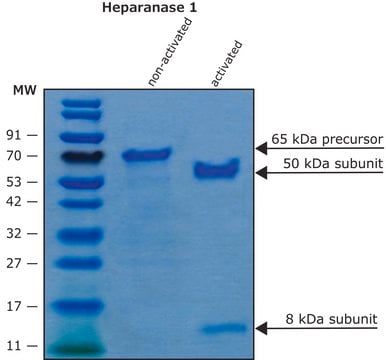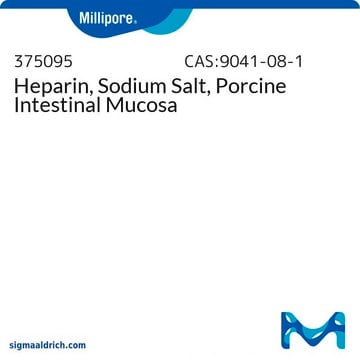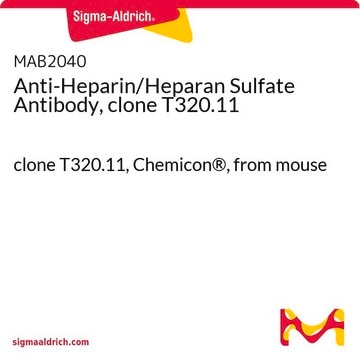H2519
Heparinase I from Flavobacterium heparinum
Lyophilized powder stabilized with approx. 25% bovine serum albumin, ≥200 units/mg protein (enzyme + BSA)
Synonym(s):
Heparin lyase I, Heparinase
Sign Into View Organizational & Contract Pricing
All Photos(1)
About This Item
CAS Number:
MDL number:
UNSPSC Code:
12352204
NACRES:
NA.54
Recommended Products
conjugate
conjugate (Glucosaminoglycan)
Quality Level
form
lyophilized solid
specific activity
≥200 units/mg protein (enzyme + BSA)
mol wt
42.8 kDa
application(s)
diagnostic assay manufacturing
storage temp.
−20°C
Looking for similar products? Visit Product Comparison Guide
Application
Heparinase I from Flavobacterium heparinum has been used:
- in the digestion of plasma samples
- to study the effect of medium, washing and sonication on the infectivity of Chlamydia pneumonia
- in enzymatic removal of heparan sulfate from the surface of human rhabdomyosarcoma cells
Biochem/physiol Actions
Heparinase I from Flavobacterium heparinum acts by cleaving the α-glycoside linkage at AT III binding site in heparin. This results in small oligosaccharide fragments . Heparinase I neutralizes the protein′s action of anticoagulation. Heparinase I possesses a half-life of 15-18 minutes.
Unit Definition
One unit (Sigma unit) will form 0.1 μmole of unsaturated uronic acid per hr at pH 7.5 at 25 °C. One International Unit (I.U.) is equivalent to approx. 600 Sigma units.
Other Notes
View more information on enzymes for complex carbohydrate analysis at www.sigma-aldrich.com/enzymeexplorer
Signal Word
Danger
Hazard Statements
Precautionary Statements
Hazard Classifications
Resp. Sens. 1
Storage Class Code
11 - Combustible Solids
WGK
WGK 3
Flash Point(F)
Not applicable
Flash Point(C)
Not applicable
Personal Protective Equipment
dust mask type N95 (US), Eyeshields, Gloves
Choose from one of the most recent versions:
Certificates of Analysis (COA)
Lot/Batch Number
Don't see the Right Version?
If you require a particular version, you can look up a specific certificate by the Lot or Batch number.
Already Own This Product?
Find documentation for the products that you have recently purchased in the Document Library.
Customers Also Viewed
HeparinHeparin - A Century of Progress, 273-273 (2012)
Wataru Hashimoto et al.
Biochemistry, 53(4), 777-786 (2014-01-21)
Pedobacter heparinus (formerly known as Flavobacterium heparinum) is a typical glycosaminoglycan-degrading bacterium that produces three heparin lyases, Hep I, Hep II, and Hep III, which act on heparins with 1,4-glycoside bonds between uronate and amino sugar residues. Being different from
Cardiopulmonary Bypass: Principles and Practice, 509-509 (2008)
Udayanath Aich et al.
Analytical chemistry, 83(20), 7815-7822 (2011-08-26)
Heparin and the low molecular weight heparins are extensively used as medicinal products to prevent and treat the formation of venous and arterial thrombi. In early 2008, administration of some heparin lots was associated with the advent of severe adverse
Differential expression of plasma microRNA in preeclamptic patients at delivery and 1 year postpartum
Murphy MSQ, et al.
American Journal of Obstetrics and Gynecology, 213(3), 367-e1-367-e1 (2015)
Our team of scientists has experience in all areas of research including Life Science, Material Science, Chemical Synthesis, Chromatography, Analytical and many others.
Contact Technical Service













